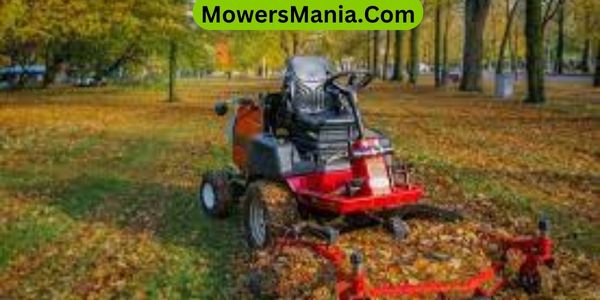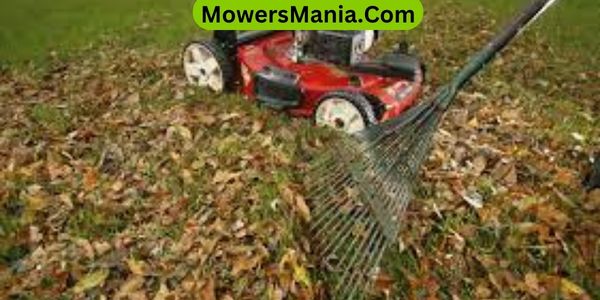You’re ready to tackle the colorful chaos of fall leaves in your yard. But the rain has turned them into a soggy mess. Can electric mowers handle wet leaves in the fall?
Let’s find out.

Understanding the Challenges of Wet Leaves
Can electric mowers effectively handle wet leaves in the fall?
It’s important to understand the challenges posed by wet leaves before attempting to tackle them with an electric mower.
Wet leaves can clump together, creating a heavy and dense layer that can be challenging for electric mowers to effectively mulch or bag.
The moisture in the leaves can also cause them to stick to the ground, making it harder for the mower to lift and mulch them.
When using an electric mower on wet leaves, the moisture can also lead to clogging issues in the mower’s blades and chute.
This can reduce the mower’s efficiency and potentially cause it to stall or require frequent cleaning during the leaf removal process.
Additionally, wet leaves can create a slick surface, making it more difficult for the mower to maneuver and maintain traction. This can result in uneven mulching or missed spots, requiring additional passes to achieve the desired results.
Understanding these challenges is crucial when considering whether electric mowers can effectively handle wet leaves in the fall.
While electric mowers can certainly be used for wet leaves, it’s important to be aware of these potential obstacles and take the necessary precautions to ensure efficient and effective leaf removal.
Benefits of Using Electric Mowers
You’ll love the benefits of using electric mowers.
They’re eco-friendly, producing zero emissions and reducing noise pollution for a more pleasant mowing experience.
Additionally, electric mowers require minimal maintenance, making them convenient and cost-effective.
Eco-Friendly Lawn Care
Using an electric mower can significantly reduce your carbon footprint while maintaining a well-groomed lawn.
Here are three benefits of using electric mowers for eco-friendly lawn care:
- Zero Emissions: Unlike gas-powered mowers, electric mowers produce zero emissions, helping to improve air quality and reduce environmental pollution.
- Noise Reduction: Electric mowers are quieter than their gas counterparts, minimizing noise pollution and creating a more peaceful outdoor environment for you and your neighbors.
- Lower Operating Costs: Electric mowers are more cost-effective to operate since they don’t require gasoline or oil, helping you save money while also being environmentally conscious.
Making the switch to an electric mower not only benefits the environment but also contributes to a healthier and more sustainable lawn care routine.
Noise and Fume Reduction
When using an electric mower, you’ll experience reduced noise and fumes compared to gas-powered mowers.
Electric mowers operate quietly, making them ideal for early morning or late evening mowing without disturbing your neighbors.
Additionally, they eliminate the need for gas and oil, thereby reducing harmful emissions and fumes that contribute to air pollution.
The table below illustrates the benefits of using electric mowers in terms of noise and fume reduction:
| Benefits of Using Electric Mowers for Noise and Fume Reduction |
|---|
| Reduced Noise |
| Zero Emissions |
| Eliminates Fumes |
Low Maintenance Requirements
Electric mowers require minimal maintenance, making them a convenient and hassle-free choice for lawn care.
Here are some benefits of their low maintenance requirements:
- No Gas or Oil Changes: Unlike traditional gas mowers, electric mowers don’t require regular oil changes or refills of gas, saving you time and money.
- Fewer Moving Parts: Electric mowers have fewer moving parts than gas mowers, reducing the likelihood of mechanical issues and the need for frequent maintenance.
- Easy Storage and Cleaning: With no gas or oil to worry about, electric mowers are easier to clean and store, requiring less maintenance effort on your part.
With these low maintenance requirements, electric mowers offer a hassle-free and environmentally friendly option for keeping your lawn in top shape.
Factors Affecting Electric Mower Performance

You need to take into account various factors that can impact the performance of your electric mower.
One important factor is the condition of the grass or leaves you’re trying to cut. Wet grass or leaves can significantly reduce the cutting efficiency of your electric mower, causing it to clog more frequently and potentially leading to an uneven cut.
Another factor to consider is the type and sharpness of the mower blades. Dull blades can reduce cutting performance and create a torn, uneven look on your lawn.
Additionally, the power source of your electric mower can affect its performance. Mowers with higher voltage or amp-hour ratings tend to handle tougher jobs better than those with lower ratings.
The size and slope of your lawn can also impact performance. Larger or hilly lawns may require a more powerful mower to maintain optimal performance.
Lastly, proper maintenance of your electric mower, including regular cleaning and blade sharpening, is essential for consistent performance.
Tips for Efficiently Handling Wet Leaves
You want to make sure that your electric mower can efficiently handle wet leaves in the fall, so it’s important to consider some key tips.
This includes understanding how wet leaves can impact efficiency and knowing the capabilities of electric mowers when it comes to handling leaves.
Wet Leaves and Efficiency
When handling wet leaves, it’s important to adjust your mowing technique to ensure efficient and effective results.
Here are three tips for efficiently handling wet leaves:
- Use a higher mower deck setting: Raising the deck of your electric mower can help prevent clogging and ensure the leaves are properly mulched, rather than becoming a wet, compacted mess.
- Mow in a slower and deliberate manner: Wet leaves can be heavier and more clumped together, so slowing down your mowing speed can help the mower effectively process the leaves without bogging down.
- Clear the mower frequently: Stop and clear the mower deck regularly to prevent buildup and ensure consistent mulching of the wet leaves.
Electric Mowers’ Leaf Capabilities
Efficiently handling wet leaves with an electric mower requires adjusting the mowing technique and following specific tips to prevent clogging and ensure effective mulching.
When tackling wet leaves, it’s crucial to reduce your mowing speed to allow the mower’s blades enough time to process the damp foliage. Ensure that the mower’s blades are sharp to facilitate smoother cutting and mulching.
Additionally, mow in overlapping rows to prevent excessive strain on the mower and to achieve a more thorough mulching of the wet leaves. It’s also advisable to mow when the leaves are only slightly damp, as excessively wet leaves can be more challenging to mulch effectively.
Lastly, consider using a mower with adjustable deck heights, as this can help in managing different leaf conditions with ease.
Tips for Wet Leaves
To efficiently handle wet leaves when mowing with an electric mower, it’s essential to mow at a slower speed and adjust the mower’s deck height accordingly. This will prevent clogging and ensure a cleaner mow.
Additionally, consider these tips for efficiently handling wet leaves:
- Choose the Right Time: Wait until later in the morning or early afternoon when the dew has dried, or after a light rain, to mow wet leaves. This will make them less likely to clump together and clog the mower.
- Overlap Your Passes: To ensure a thorough job, overlap your mowing passes by about 25%. This helps in breaking up the wet leaves and ensures they’re mulched more effectively.
- Clean the Mower After Use: After mowing wet leaves, take the time to clean your mower thoroughly to prevent any leftover debris from causing issues during the next use.
Maintenance and Care for Electric Mowers
Regular maintenance is essential for keeping your electric mower in top condition for handling various types of debris.
Start by regularly inspecting the mower blades for any signs of wear and tear. Sharpen or replace the blades as needed to ensure efficient cutting performance.
Additionally, clean the undercarriage after each use to prevent grass and debris buildup, which can affect the mower’s ability to handle wet leaves in the fall.
Check the air filter and replace it if it’s dirty to maintain proper airflow and engine performance.
Keep an eye on the mower’s battery, ensuring it’s charged and stored properly to avoid issues during operation.
It’s also important to check the wheels and adjust the cutting height as necessary.
Lastly, store your electric mower in a clean, dry place to prevent rust and other damage.
Following These Maintenance Tips For Your Electric Mower

After following these maintenance tips for your electric mower, you can ensure that it’s well-prepared to handle wet leaves and other debris in the fall. Taking care of your electric mower not only extends its lifespan but also ensures optimal performance when tackling fall’s challenges.
Here are some final thoughts to keep in mind as you prepare for the upcoming season:
- Regular Inspections: Keep an eye on the condition of your mower’s blades, ensuring they’re sharp and free of any damage. Also, check for any loose parts or signs of wear and tear that may affect its performance.
- Battery Maintenance: If your electric mower uses a battery, make sure it’s fully charged and in good condition before the fall season starts. Consider having a spare battery on hand for longer mowing sessions.
- Storage: Properly store your electric mower during the off-season. This includes cleaning it thoroughly, removing any debris, and storing it in a dry, sheltered area to prevent rust or damage.
Frequently Asked Questions [FAQs]
Are There Any Specific Safety Precautions to Consider When Using an Electric Mower on Wet Leaves?
When using an electric mower on wet leaves, it’s important to prioritize safety. Ensure proper footwear, avoid mowing on steep slopes, and always maintain a firm grip on the mower. Additionally, be mindful of potential slippery spots.
How Does the Weight and Size of an Electric Mower Impact Its Ability to Handle Wet Leaves?
When using an electric mower on wet leaves, consider the weight and size. Larger, heavier mowers may handle wet leaves better, providing more stability and traction. Lighter mowers could struggle with wet leaves, potentially leading to clogging or reduced efficiency.
Can Electric Mowers Be Used to Mulch Wet Leaves, and Are There Any Special Considerations for This Task?
When mulching wet leaves with an electric mower, ensure the blades are sharp and the mower has enough power to handle the moisture. Take care to avoid overloading the mower, and consider using a mower with a higher horsepower for better performance.
Are There Any Specific Types of Blades or Attachments That Can Improve an Electric Mower’s Performance on Wet Leaves?
When mulching wet leaves in the fall, consider using high-lift blades or mulching attachments to improve your electric mower’s performance. These can help increase airflow and cutting efficiency, making it easier to handle wet leaves.
What Are the Potential Risks or Damage to the Mower When Using It on Wet Leaves, and How Can These Be Minimized?
When using an electric mower on wet leaves, potential risks include clogging and damage to the motor. To minimize these, ensure the mower’s blades and chute are clear, and mow at a slower pace, allowing the mower to handle the wet leaves more effectively.
Conclusion
In conclusion, electric mowers can handle wet leaves in the fall with the right techniques and maintenance.
Understanding the challenges, utilizing the benefits, and considering the factors affecting performance are key in efficiently handling wet leaves.
With proper care and maintenance, electric mowers can effectively tackle the task, making leaf clean-up in the fall easier and more eco-friendly.



